The Intel Core i9-9900K at 95W: Fixing The Power for SFF
by Ian Cutress on November 29, 2018 8:00 AM ESTCPU Performance: Encoding Tests
With the rise of streaming, vlogs, and video content as a whole, encoding and transcoding tests are becoming ever more important. Not only are more home users and gamers needing to convert video files into something more manageable, for streaming or archival purposes, but the servers that manage the output also manage around data and log files with compression and decompression. Our encoding tasks are focused around these important scenarios, with input from the community for the best implementation of real-world testing.
All of our benchmark results can also be found in our benchmark engine, Bench.
Handbrake 1.1.0: Streaming and Archival Video Transcoding
A popular open source tool, Handbrake is the anything-to-anything video conversion software that a number of people use as a reference point. The danger is always on version numbers and optimization, for example the latest versions of the software can take advantage of AVX-512 and OpenCL to accelerate certain types of transcoding and algorithms. The version we use here is a pure CPU play, with common transcoding variations.
We have split Handbrake up into several tests, using a Logitech C920 1080p60 native webcam recording (essentially a streamer recording), and convert them into two types of streaming formats and one for archival. The output settings used are:
- 720p60 at 6000 kbps constant bit rate, fast setting, high profile
- 1080p60 at 3500 kbps constant bit rate, faster setting, main profile
- 1080p60 HEVC at 3500 kbps variable bit rate, fast setting, main profile
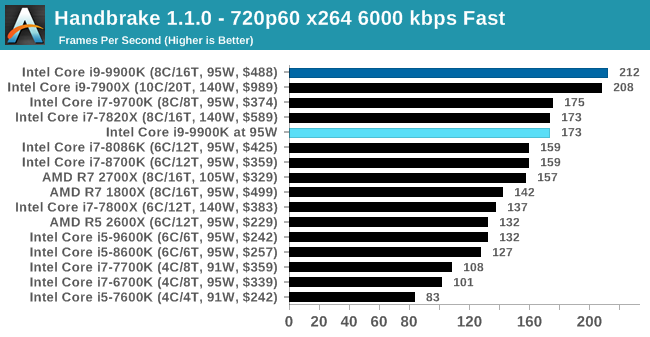
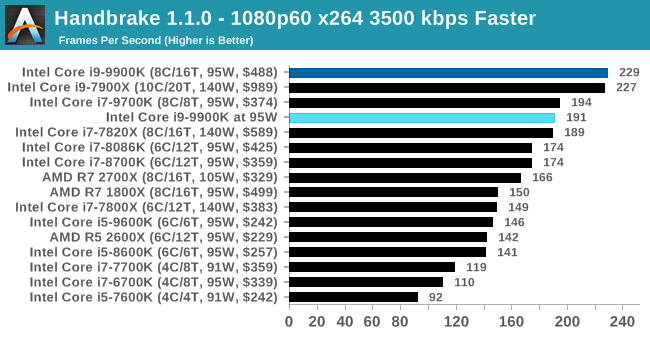
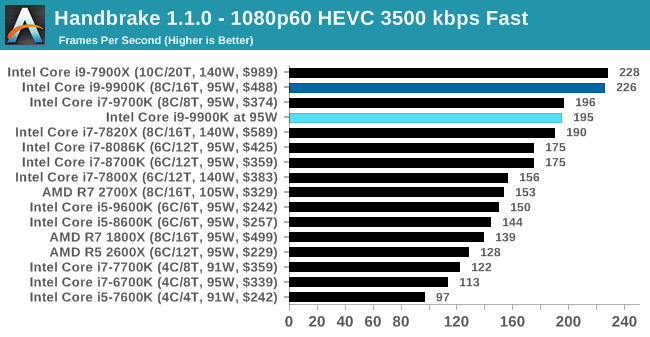
Encoding is a good example where the performance decreases by a noticable margin (10%+), although perhaps not as much as you might think. In all of our tests however, the 95W mode again pulls the 9900K down to the level of a 9700K. This pattern goes through all of our encoding tests.
7-zip v1805: Popular Open-Source Encoding Engine
Out of our compression/decompression tool tests, 7-zip is the most requested and comes with a built-in benchmark. For our test suite, we’ve pulled the latest version of the software and we run the benchmark from the command line, reporting the compression, decompression, and a combined score.
It is noted in this benchmark that the latest multi-die processors have very bi-modal performance between compression and decompression, performing well in one and badly in the other. There are also discussions around how the Windows Scheduler is implementing every thread. As we get more results, it will be interesting to see how this plays out.
Please note, if you plan to share out the Compression graph, please include the Decompression one. Otherwise you’re only presenting half a picture.

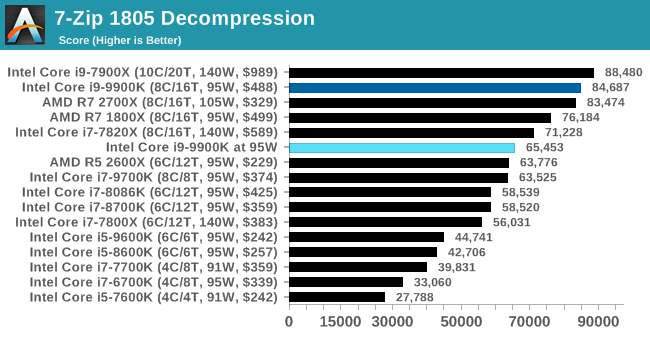
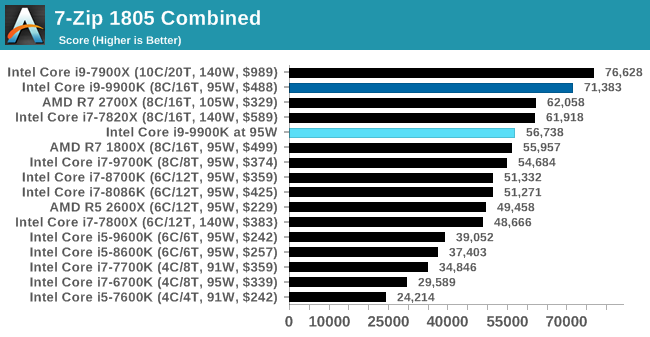
WinRAR 5.60b3: Archiving Tool
My compression tool of choice is often WinRAR, having been one of the first tools a number of my generation used over two decades ago. The interface has not changed much, although the integration with Windows right click commands is always a plus. It has no in-built test, so we run a compression over a set directory containing over thirty 60-second video files and 2000 small web-based files at a normal compression rate.
WinRAR is variable threaded but also susceptible to caching, so in our test we run it 10 times and take the average of the last five, leaving the test purely for raw CPU compute performance.

AES Encryption: File Security
A number of platforms, particularly mobile devices, are now offering encryption by default with file systems in order to protect the contents. Windows based devices have these options as well, often applied by BitLocker or third-party software. In our AES encryption test, we used the discontinued TrueCrypt for its built-in benchmark, which tests several encryption algorithms directly in memory.
The data we take for this test is the combined AES encrypt/decrypt performance, measured in gigabytes per second. The software does use AES commands for processors that offer hardware selection, however not AVX-512.











101 Comments
View All Comments
edzieba - Thursday, November 29, 2018 - link
The difference is the ARM chips being labelled with the short-term term frequencies and performance, while Intel put the steady state values on the box. Motherboard manufacturers throw the box values right out the window, but if Intel were to dictate /those/ the wailing and gnashing of teeth from the peanut gallery would be cacaphonous.melgross - Thursday, November 29, 2018 - link
Its just a matter of semantics. It doesn’t have to be spelled out.Targon - Thursday, November 29, 2018 - link
There are actually three primary states. Base clocks, boost or turbo speeds, and then you can get thermal throttle which will actually lower the speed below the base clock speed. If the i9-9900k has a base of 3.6GHz, a turbo that goes up to 5GHz, but you have poor cooling, you may be seeing the CPU sticking to that 3.6GHz, or even below it if the temperatures get too high.This is where those very thin laptops may have Ryzen versions performing better than Intel, because of the temperatures keeping the chip running at or even below base speeds. For a small form factor machine, will the 9900k be running at base speeds ALL THE TIME due to temperatures/TDP/cooling? In the same small form factor case, would a Ryzen 7 2700X end up having a similar level of performance after several hours(to allow the heat generation to stabilize)? If you start when things are COLD, you could turn the machine on and run benchmarks, and see better numbers than if the machine were already on and you had been running intensive applications for several hours prior to running the benchmarks.
eastcoast_pete - Thursday, November 29, 2018 - link
@Ian: Thanks for this informative test and review. One comment, one question/request. Comment: I continue to be struck by Intel's prowess when AVX512/AVX2 comes into play. I am also (negatively) impressed by the thermal load use of these instructions causes. The reduction in performance when using AVX512/AVX2 under strict adherence to a TdP of 95 Wh speaks volumes. Did you ever have a chance to ask Intel why running AVX makes their chips so power-hungry? Even if not, I'd appreciate your thoughts on why AVX makes Intel's chips run so hot.Here my question/request: I now that you/Anandtech have a large dataset on x264 video encoding speeds. However, especially for i7s and AMD's six-core and up Zen chips, I'd like to know how they fare when encoding/transcoding a 2160p 10bit video, as that is now in increasing demand, and really makes the processor sweat (and slow down, a lot). Any chance you and your colleagues can add that to the encoding tests? If space is an issue, I suggest to dump the x264 720p speed test; even a lowly Athlon or Celeron chip does that quite well, and at good speed.
HStewart - Thursday, November 29, 2018 - link
I believe you can turn off AVX512 in bios - it use in special application that need the speedAlso I would think the external GPU's is another major factor in considering power requirements on a system.
I don't belkieve there is any power needs or reduction in topp speed for AVX2 only that AVX512 uses extra power on system and top frequency are reduce if being used.
One thing about AVX2 - on Intel it is 256bit and AMD has dual 128 bits currently - not sure about new Zen's coming out next year. But at least with PowerDirector, it give you significantly performance increase
GreenReaper - Saturday, December 1, 2018 - link
It's pretty simple, really: the more data the CPU has to process in parallel, the more horsepower it uses. It's like doubling or quadrupling the number of active cylinders in an engine - you gain performance, but it requires more power and produces more heat. That's why they're off if not in use.Dedicated GPU blocks for video coding will also use more power, but are likely to be far more efficient than doing the operations with general code - as long as it's within their defined capabilities. (Similarly, if you had to do the equivalent of the AVX operations without the relevant hardware, it would probably use even more power than it currently does, at least over the extra time it took.)
Davenreturns - Thursday, November 29, 2018 - link
I have found much confusion among the readers on hardware review websites when it comes to this issue. So I would like to present some information from Anandtech's Bench tool in order to clarify the situation for me and others hopefully:Looking at the CPU Power Bench
https://www.anandtech.com/bench/CPU-2019/2194
The following two processors have these results under full package, full load:
i7-6700k 82.55W First mainstream desktop 14 nm processor, 95W TDP according to Intel
i9-9900k 168.48W Latest mainstream desktop 14 nm processor, 95W TDP according to Intel
I assume that these two values were measured in unlimited mode. If this is the case, this means that the power listed above is when all cores/threads are loaded at full max turbo mode. So if you are expecting a certain level of performance given that Intel advertises 95W for both CPUs, then you are being misled and may not get the performance you are expecting when upgrading the CPU but not your cooling.
This is a CHANGE from the past in how Intel uses TDP without telling the customer. It also highlights that Intel use to be conservative with cores/clocks/turbo when they had no competition and were able to shrink nodes between Nehalem and Skylake. Now they are PRETENDING that they can just double the cores and raise clocks on the same node and not increase power. Please correct me if I'm wrong, but it doesn't look like this is the case anymore.
AlyxSharkBite - Thursday, November 29, 2018 - link
Really interesting how when you limit it to 95W it’s really close to the 2700X4800z - Thursday, November 29, 2018 - link
A power unlimited 2700x. Also this article doesn't include any games. If it did you'd see the 9900k still does much better, because games don't use all 8 cores.schujj07 - Thursday, November 29, 2018 - link
2700X - 117.18W Max = 11.6% over stated TDP9900K - 168.48W Nax = 77.3% over stated TDP
Don't forget not everyone views gaming and the end all be all form of benchmarking. Would it be interesting to see if it affects the gaming sure. It most certainly would affect those who game and stream at the same time.